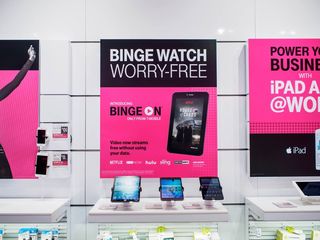Binge On is flawed and John Legere needs to stop defending it

T-Mobile CEO John Legere is concerned — confused, frankly — by the way Google and the EFF have reacted to Binge On recently. He can't figure out why everyone doesn't love the way he's giving his customers choices that no other carrier is offering, and is downright angry at the people confusing his customers by claiming his company is doing something they shouldn't be doing in order to offer people all the free video they can consume. He knows his customers love it — they tell him on Twitter every day — which is a big part of why this whole accusation of throttling is so confusing and concerning.
Well, John, let me spell it out for you.
Let's first stop by the T-Mobile website advertising Binge On. Without a doubt, this is a pretty sweet deal. Unlimited free video streaming from the services T-Mobile has partnered with, and in return all you have to do is let T-Mobile limit the quality of that video to DVD quality, which is usually right around 480p, or "standard definition." Better still, this feature costs you nothing and is available to anyone paying for more than 3GB of monthly data. Sure, it doesn't cover every single streaming service right now, but it's a new service and growing all the time. If you want to watch something in HD, you need only flip a switch and disable Binge On. Simple stuff, and a seriously generous offer on T-Mobile's part.
Before YouTube can compensate for the dramatic decrease in available bandwidth, the user is left with a stuttering, buffering video for seemingly no reason.
What isn't mentioned anywhere on the first page of this marketing site is what happens when you watch something from a service that isn't a Binge On partner. To get any information on that at all, you have to head down to the little FAQ at the bottom of the page, hidden by javascript. Open the first bubble and you'll see "almost all other video streaming is optimized for mobile so you watch 3 times more video with your data plan" in the explanation for how Binge On is going to work. No other details, just "optimized for mobile" and a vague benefit to how much more data you get to spend on other things. That doesn't sound like a bad thing at all, and it's not like we won't see almost everyone partner with T-Mobile eventually.
Here's where things get fuzzy. YouTube — without a doubt the biggest video streaming service on the planet — is not a Binge On partner. When T-Mobile tries to "optimize" a YouTube stream through Binge On, the end result fits into the wrong side of that "almost" we saw in the FAQ. YouTube sees the speed of your connection to its servers and offers you a video file that matches that speed, so you ge the best quality without any problems. When your connection allows for 10mbps, you get an HD file. But when Binge On sees that video file, it slows the connection down to 1.5mbps to force YouTube to "optimize" for your screen. Before YouTube can compensate for the dramatic decrease in available bandwidth, the user is left with a stuttering, buffering video for seemingly no reason.

That's a weird situation for YouTube to be put it, and it gets even weirder. Binge On is so great that it's on by default. Every T-Mobile customer with more than 3GB of data has Binge On enabled as soon as the phone connects to the network. If you don't want BingeOn, you have to disable it yourself. T-Mobile makes this easy, but they don't make it particularly clear that a significant number of streaming and buffering issues from video services that aren't Binge On partners are happening because of Binge On. Users who aren't even aware of how Binge On is functioning — because it's not explained clearly anywhere — aren't going to blame T-Mobile for a poor experience. They're going to blame the content providers, and the only ways the content providers can get around this problem is to either partner with T-Mobile or tell their customers that T-Mobile is why the stream isn't as good as it should be.
BingeOn is on by default because it saves T-Mobile a whole lot of bandwidth, which means it saves T-Mobile a whole lot of money.
You see, Mr. Legere, you are offering a service that is on by default and causes problems with services you aren't partnered with. YouTube pointed out that Binge On was the problem, and you blew them off. The EFF pointed out that not only is Binge On the problem for YouTube, but for any video file over an HTTP connection that isn't part of the Binge On partnership. You responded by telling your audience that this special-interest group was misleading customers and just wanted attention. You're looking at facts and calling them bullshit with a smile and a wave, only that doesn't make those facts go away.
Be an expert in 5 minutes
Get the latest news from Android Central, your trusted companion in the world of Android
Binge On is on by default because it saves T-Mobile a whole lot of bandwidth, which means it saves T-Mobile a whole lot of money. If you made Binge On an opt-in service, fewer people would use it because there's always going to be people out there who either don't care enough to enable the feature or don't know to turn it on because the phone was a gift or they weren't listening to the rep during the purchase process. Those same people are now using Binge On and can't figure out why YouTube and other services aren't working very well right now, and you keep telling those people it couldn't possibly be your fault when there's a ton of evidence suggesting the opposite.

Yes, you can turn Binge On off anytime you want. Yes, T-Mobile has made that abundantly clear at just about every turn. The problem has never been the ability to disable the service in order to get the highest quality experience, although it is worth mentioning the ability to disable this feature is fairly well buried in the T-Mobile app. The problem is in that "almost" from the little bit of text hidden on the T-Mobile site advertising Binge On, and the knowledge that the single largest video service on the planet fits in that category. Users aren't going to disable Binge On if they don't know it's part of the problem, and with the CEO swearing that Binge On is a good thing and couldn't possibly be the problem because it's a service that offers choice, you are being part of the problem on purpose.
This is an incredibly cool service to offer your customers, but acting like there aren't problems and responding to legitimate criticism with an insult-riddled blog and video is just plain wrong. In fact, it's the least uncarrier thing you could do in this situation. Instead of dancing around the issue and spinning it so everyone else looks like the bad guy, why not be the good guy and admit the service is flawed. And then fix it.

